Best portable power station of 2024
Charging up the best portable power stations
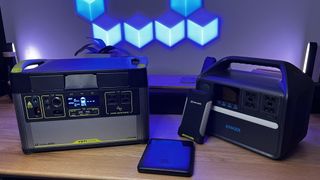
My team and I have personally tested more than 30 of the best portable power stations - but these are the ones we recommend, wherever you need a reliable power supply.
This month, we've re-assessed our featured line-up to make sure each of our reviewed models offer adequate capacity, ports, and portability for the home and outdoors. The EcoFlow Delta 2 Max is the best portable power station overall - but with the latest EcoFlow Delta Pro 3 currently under review here, we could have a new contender for the top spot soon.
Check out our featured round up below - and for more savings, we're getting ready to track down the best Black Friday portable power station deals.
The quick list
Want to find out what the best portable power stations are? Below, you’ll find a roundup of our choices. You can jump to a more detailed review of every pick, along with our price comparison tool to help you find the best deals.
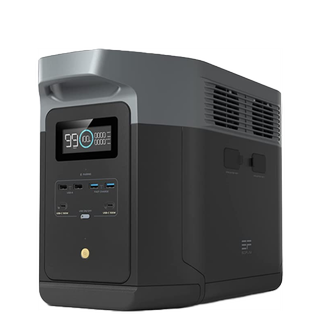
Best portable power station overall
EcoFlow has built a massive machine in capacity and ability with the Delta 2 Max. It has a maximum capacity of 6144Wh and can charge 15 independent outputs simultaneously, with 6 being full 3-pronged AC outlets.
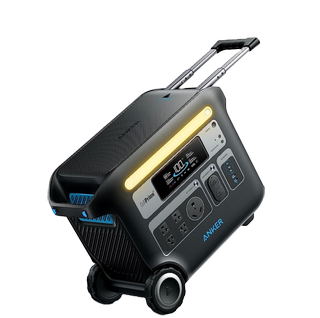
Best portable power station for outdoors
The Anker PowerHouse 767 power station has a built-in retractable arm and wheels. In addition to four standard three-pronged outlets, this also has two car sockets, USB-C ports, USB-A ports, a TT-30 port for RVs, and a built-in light bar.
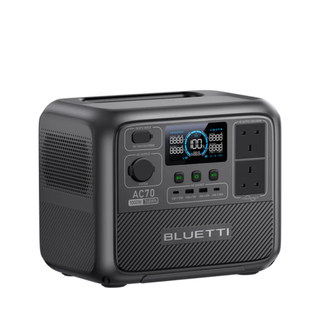
Best budget portable power station
The Bluetti AC70 is a well-rounded, compact, and budget-conscious power station ideal for travel, backing up certain items, van life, and then some. It offers a 1000W pure sine wave inverter with a 2000W Power Lifting Mode, making it fantastic for charging smaller appliances, laptops, and phones.
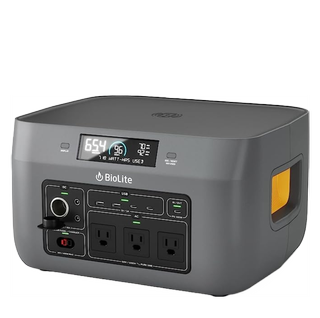
Best portable power station for camping
The BioLite BaseCharge 1500 is a great portable power station for many reasons. It's lightweight, has great charging abilities, and has a solid battery size.
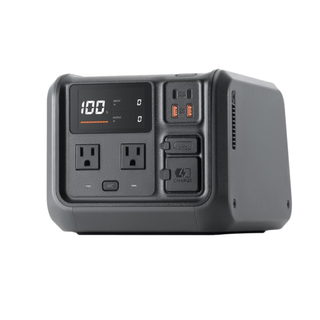
Best portable power station for drones
The DJI Power 500 might look like any ordinary compact power station, but it has something most do not: an SDCLite port for charging DJI drones on the go.
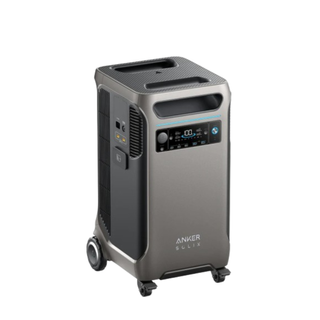
Best high-capacity portable power station
The Anker Solix F3800 is an impressive power station with a 3840Wh battery capacity. It might be pushing the definition of 'portable' a bit far - it's a tall, heavy unit. But what makes this power station truly impressive is the ability to use two units with several batteries to run your house via the Solix Home Power Panel.
The best portable power station of 2024
Why you can trust TechRadar
Below, you'll find full write-ups for each of the best portable power stations on our list. We've tested each one extensively, so you can be sure that our recommendations are trustworthy.
Best portable power station overall





1. EcoFlow Delta 2 Max
Our expert review:
Specifications
Reasons to buy
Reasons to avoid
✅ You want the Cadillac of portable power stations: This is EcoFlow's top-tier portable power station with all the bells and whistles including Bluetooth and Wi-Fi connectivity to track metrics, divert power, and check status.
✅ You want six three-pronged AC Outlets: EcoFlow's full-featured option stands out with its six three-pronged AC outlets, unlike the usual two-pronged ones.
✅ You want solar options: If you're looking for a high-capacity portable power station that can also recharge off the grid using the sun, the EcoFlow Delta 2 Max has fantastic solar panels that recharge the large battery quickly.
❌ You’re looking for a mid-priced portable power station: EcoFlow's Delta 2 Max is just under $2000 base, with an additional $500 - 600 for the solar panels, and another $1400 for an extra battery. It's pricy, but EcoFlow runs deals occasionally dropping that price a bit.
❌ You want wireless charging: The trend these days with portable batteries, regardless of the main intent of the battery, is to include wireless charging. This power station missed the memo though, without qi charging built in.
❌ You need wheels to tote this around: Sometimes when power banks get this big and heavy, manufacturers add wheels to help when moving the power station. EcoFlow didn't feel that was necessary for the Delta 2 Max though.
🔋 The Delta 2 Max is EcoFlow's top-tier portable power station with phenomenal performance, plenty of ports, expandability, and solar input. This model even has Bluetooth and Wi-Fi connectivity which pairs with a companion app, allowing for even more detailed control and metrics. ★★★★★
What you need to know
The EcoFlow Delta 2 Max Portable Power Station is impressive. Not only is it a demanding power station due to its stature, but also because of just how well it works. It has the ability to charge nearly all appliances in a home in case of a power outage, it can run solely from 1000W Max solar power input if desired, it can be expanded up to 6kWh with additional batteries, and it even has an attachment to be a plug and play solution to take over as smart-controlled redundant backup in case of a power outage at your house. Usually, portable power stations have some cool features, but the EcoFlow Delta 2 Max seems to be in a race of its own, ahead of the pack with quite a few remarkable specs to find in a portable model.
Design: The overall design of this portable power station is fairly simple. Unlike what we normally see on power stations with the control panel and outlets on the widest side of the device, this power station uses the narrower side as the interface side, with the exact opposite side (the other narrow side) being the place to plug in cables to add power to the bank and all the AC outlets are back there too. If you want to take advantage of the extra power banks, the ports for those connections live on the right side if you're looking at the control panel. On the left lives some vents to help circulate air.
Performance: During our time testing the EcoFlow Delta 2 Max, it performed wonderfully without any issues. We could easily connect to the smart features and perform some firmware updates, and we were up and running in no time. Even while this thing is running a heavy load, it's still whisper quiet compared to what we would expect, especially compared to an equivalent gas generator. The solar panels are easy to unfold and set up if you harness the sun's power for your electricity. Beyond that, we were also shocked by how fast the battery fully charged. According to the spec sheets, this massive battery charges to 80% in 1.1 hours on standard AC outlet power, or 43 minutes utilizing the 1000W solar input in addition to the AC outlet.
Battery Capacity: Looking again at the specsheets, the EcoFlow Delta 2 Max's max battery capacity with two battery packs is over 6kWh at 6144Wh. Without the extra battery packs, the main unit still has a maximum battery capacity of 2048Wh.
Value for money: The package we have is worth about $2,540. That includes the main unit and a pack of 220W solar panels. If you wanted to choose to pick up both battery extensions and solar panels, a fully kitted system would run well over $5,000. But, depending on what you will be using the system for, that may be entirely worth it.
The Delta 2 Max is EcoFlow's top-tier portable power station with phenomenal performance, plenty of ports, expandability, and solar input. This model even has Bluetooth and Wi-Fi connectivity which pairs with a companion app, allowing for even more detailed control and metrics.
Editor's note: EcoFlow has just released the Delta Pro 3 Portable Power Station, and it will probably beat out the Delta 2 Max. So far, the Delta Pro 3 has surprised us. It’s more robust than the Delta 2 Max, has a better port offering, better doors to protect the ports, an easy-to-use handle and better wheels, a much higher battery capacity, and can be easily expanded. All around, this thing is an absolute beast in every way, all while still being quite portable and fair for the cost of the unit.
| Attributes | Notes | Rating |
|---|---|---|
| Price | Expensive, but high quality | ★★★★☆ |
| Design | Simple, powerful, lightweight | ★★★★★ |
| Performance | Outstanding, while quiet | ★★★★★ |
| Battery Capacity | Large capacity, can be expanded | ★★★★★ |
Best portable power station for outdoors




2. Anker 767 PowerHouse
Our expert review:
Specifications
Reasons to buy
Reasons to avoid
✅ You want a high capacity battery: This battery is quite large coming in at 2048Wh. With an expansion, it can jump to 4096Wh. That's a huge, currently matching our #1 in size.
✅ You want an easy to maneuver powerstation: The Anker 767 PowerHouse has built in wheels and a retractable handle to make moving this beast of a powerstation as easy as moving a suitcase.
✅ You have an RV: The 767 PowerHouse boats quite a few ports, one of the most surprising is the inclusion of the TT-30R outlet, which is used heavily by RVs.
❌ You’re looking for a lightweight power station: The Anker PowerHouse 767 is not for the faint of heart. It weighs a whopping 67lb. Granted, it has wheels, but it's still hefty.
❌ You want a kWh of battery backup: Even with the battery extension, this power station maxes out at 4096Wh, just under half of a kWh.
❌ You want easy home installation as a backup: While this power station could absolutely run aspects of your home, and, with some fancy wiring, could be ran into your main breaker, that's not something this model promotes.
🔋 The PowerHouse 767 is Anker's (Anker Solix)'s flagship portable power station, and it shows. It has a wide range of ports, great capacity, easy maneuverability and a built in light bar. What more could you ask for? ★★★★★
What you need to know
Anker's PowerHouse 767 Portable Power Station is an impressive power station, to say the least. It thrives in the outdoors, though, in our mind. Yes, it could be used just around the house, but with the built-in wheels, RV outlet, and built-in light bar, this feels like a portable power station designed to be taken on fun adventures and put to the test. While we did not get them to test, we can get solar panels with this power station, as we see with many high-end models. Also, this power station can be controlled via the companion app. We can divert power to certain port types through the app, see the discharge or recharge status, and much more.
Design: As mentioned, this massive portable power station has a few unique features worth noting. First, this power station has wheels and a retractable handle, much like a rolling suitcase. The wheels are rugged enough and large enough to go over some outdoor terrain, and the handle can hold well over the weight of the PowerHouse 767. Next, this power station has an RV outlet. We've seen a lot of power stations, and not many have this outlet. So, if you have an RV and are looking for a power station, knowing that this could run your entire RV if needed is a huge gain. In fact, pro tip, if where you are staying does not have one, this could even act as an adapter. Lastly, this power station has a built-in, multi-brightness LED light bar to help illuminate whatever you are plugging in, your campsite, garage, or wherever you are.
Performance: I noticed that everything worked as promoted while reviewing the Anker PowerHouse 767 Portable Power Station. We could dial in every aspect of how this power station operated, including details like how quickly (balanced with how loudly) the unit recharged, we could trigger a light SOS mode in an emergency, toggle power save mode, and more. As we have seen on most portable power stations with companion apps or zone control, we can enable or disable ports by type, i.e., enable all AC outlets simultaneously.
Battery Capacity: 2048Wh is a large battery. When writing this, it also matches our number one offering in size. Without breaking beyond the portable power station size, this is probably one of the larger options you will find. Even the fact that this model has wheels should tell you that it's no longer portable beyond this. Because of that, we think the capacity has hit its sweet spot when you need portable power.
Value for money: The Anker PowerHouse 767 portable power station is reasonably priced for what it is and all that it can do. At the time of writing, the base cost for just the PowerHouse is $2000. If you want to add the expansion, that's going to be another $1000, if instead you wanted to add 3x 200W solar panels, the price jumps $3000 from the original cost, and so on. It's expensive, but sometimes the things you want are not what "fits in the budget", but still end up being a fantastic choice.
The PowerHouse 767 is Anker's (Anker Solix) flagship portable power station, and it shows. It has a wide range of ports, great capacity, easy maneuverability, and a built-in light bar. What more could you ask for?
| Attributes | Notes | Rating |
|---|---|---|
| Price | Well priced for the features and size | ★★★★★ |
| Design | A great design making it easy to move | ★★★★★ |
| Performance | Works great, lightbar included | ★★★★☆ |
| Battery Capacity | Great capacity overall | ★★★★★ |
Best budget portable power station




Specifications
Reasons to buy
Reasons to avoid
✅ You want a small, reliable power station: It is only 22.5lb, making it ideal for home life or on-the-road use, all while still being from a reputable company.
✅ You need versatile charging options: This unit offers every port you may need, on a small unit. This thing has the ports to charge any device you may need, as long as it’s not too large.
✅ You want fast recharging: The Bluetti AC70 can recharge from 0 to 80% in 45 minutes, which is relatively fast for power stations in this class.
❌ You need a high-capacity power station: The AC70 is one of the smaller power stations Bluetti offers, with only a 768Wh capacity and 1000W output (2000W in Power Lifting Mode). Because of this, the AC70 is more designed for small to mid-size needs.
❌ You want rugged outdoor capabilities: Though this unit is small enough that you may want to carry it camping or on an outdoor adventure where you still need a decent amount of power, the AC70 is not rated well for outdoor use or water exposure.
❌ You want the ability to expand in the future: While many Power Stations can expand with battery packs, the AC70 does not allow for battery expansion, meaning you cannot add battery capacity to this unit.
🔋 The Bluetti AC70 is a highly versatile and portable power station. It is ideal for home and vehicle use and light camping. The power station is compact, offers excellent charging options, and recharges quickly. However, it might not be suitable for more demanding power needs or rugged environments.
★★★★
What you need to know
The Bluetti AC70 is a small portable power station with 768Wh battery capacity and an ultra-portable design. We can quickly put this in a bag or the backseat of a car without any problems. There is no extra battery addition, but we're not shocked about a device this small. The Bluetti AC70 is well-priced, works well, and has some quick charging options, which are helpful. Much like other portable power stations, there is a way to control which kind of power ports will receive power. For this model, we can control whether the AC or car/cig outlets work and the USB-A and USB-C ports stay operational.
Design: The power station features a basic cube design with a front panel hosting all the outputs, ensuring easy access to all the ports. The inputs including both solar and AC are located on the right side of the unit.. Additionally, the top back corner of the power station features an integrated handle, making it more convenient to carry around.
Performance: The Bluetti AC70 delivers reliable and efficient operation. It includes a Pure Sine Wave inverter, which ensures a stable power output and protects sensitive devices from power fluctuations or damage. Whether charging electronics, running small appliances, or using power tools, this power station provides a consistent and safe power supply.
Battery Capacity: The Bluetti AC70 has a 768Wh battery, providing a decent amount of power considering its compact size. While it may not have the ability for battery expansion, this unit can be connected to a B80 unit over an Aviation to XT60 cable and grow to 1574Wh.
Value for money: The AC70 from Bluetti offers excellent value, especially considering its functionality and performance. It costs just over $370 right now with a sale and provides a cost-effective solution for portable power needs. While the optional solar panel combo may increase the overall cost, it offers the convenience of harnessing renewable energy to recharge the power station, making it even more versatile and environmentally friendly.
Read our full Bluetti AC70 review
| Attributes | Notes | Rating |
|---|---|---|
| Price | Well priced for feature set | ★★★★☆ |
| Design | Very simple design overall | ★★★★☆ |
| Performance | Easy operation, quick charging | ★★★★☆ |
| Battery Capacity | For the size, good capacity | ★★★★☆ |
Best portable power station for camping







Specifications
Reasons to buy
Reasons to avoid
✅ You want a highly versatile power station: Sometimes when camping, you need to keep some electronic essentials, with the BaseCharge 1500 or 600, that's now easily doable.
✅ You want wireless charging: This power station has a wireless charging top, with a somewhat helpful top material to help hold your phone where it needs to be to charge.
✅ You want an easy to use LCD screen: The LCD readout on this power station is simple and helpful.
❌ You’re looking for quick re-charge: The 1500 model takes over 13 hours to recharge, which is quite a long time for this size battery.
❌ You want expandable capacity: BioLite does not have expansion battery packs or the ability to add on.
❌ You want UPS mode: While you can use this device while plugged in, BioLite did not include true UPS mode.
🔋 The BaseCharge 1500 is BioLite's largest offering, with the smaller of the two being a 600 model. Both models look identical and work very well. Both have wireless charging on the top and ports on the front. ★★★★½
What you need to know
The BioLite BaseCharge 1500 and 600 look identical. The only differences are that the 1500 model has slightly more ports and a larger battery. Both models have the 10W wireless charger on the top, an energy odometer, and solar charging capability. The 1500 has 1521Wh, and the 600 model has 633Wh. BioLite not only has a great product, but it also provides energy to over 5 million people worldwide who rely on BioLite to power their homes.
Design: The BioLite BaseCharge 1500 and 600 have two handles to help carry them from campsite to vehicle or storage to home-turned-campsite, thanks to the lack of power. All of the ports in and out of these power stations are on the front of the unit. Each bank of port types has a single button to enable power to those ports, except for the USB-A and USB-C ports.
Performance: The BioLite BaseCharge 1500 offers wall outlet performance anywhere. We can run multiple ports at a time and have a great range of ports that can be plugged in. The maximum output is 1200W, and a surge possibility of 2400W. The solar panels can charge the BaseCharge in 4 hours if you use a maximum of four 100W panels.
Battery Capacity: Thanks to the 1521Wh on board, this battery can power the average fridge for up to 20 hours, could charge a laptop over 20 times (depending on the laptop), or it could charge tools at a worksite or light at a campsite.
Value for money: The BioLite BaseCharge provides excellent value for the available features. BioLite has two BaseCharge models, the 1500 and 600. Naturally, the smaller of the two options is a bit cheaper, however it lines up with the drop in capacity as well.
The BaseCharge 1500 is BioLite's largest offering, with the smaller of the two being a 600 model. Both models look identical and work very well. Both have wireless charging on the top and ports on the front.
Read our full BioLite BaseCharge 1500 review
| Attributes | Notes | Rating |
|---|---|---|
| Price | Well priced for features | ★★★★☆ |
| Design | High functioning design | ★★★★☆ |
| Performance | high end performance from a little box | ★★★★☆ |
| Battery Capacity | Multiple options to match your need | ★★★★☆ |
Best portable power station for drones






Specifications
Reasons to buy
Reasons to avoid
✅ You own a DJI drone: The built-in SDC port is designed to charge DJI drones.
✅ You need power in the field: This is ideal for creators and adventurers who require a portable power source for various devices and drones.
✅ You appreciate a quiet power station: The device operates quietly at up to 25dB, suitable for noise-sensitive environments.
❌ You don't have a drone: Without the need for the SDC port, other power stations might offer more versatile ports for general use.
❌ You need a rugged device: This power station is not designed for harsh outdoor conditions.
❌ You seek the highest capacity: Larger capacity options are available for those needing more power.
🔋 The DJI Power 500 is a compact and efficient portable power station, perfect for drone enthusiasts and creators needing reliable power in the field. Its unique SDC port for DJI drones sets it apart, though its plastic build and lack of ruggedness might not appeal to everyone. For those within its niche, it's an excellent choice. ★★★★☆
What you need to know
The DJI Power 500 is designed to be a versatile power source for drone pilots and creators on the go. It offers a mix of ports, fast charging, and a quiet operation, making it suitable for various outdoor activities, provided ruggedness is not a primary concern.
Design and Build Quality: The Power 500 features a clean, black design with a plastic chassis and rubberized feet. While not rugged, it is lightweight and includes a well-designed handle for easy carrying.
Performance: The device performs reliably, charging various devices efficiently. The LCD screen provides clear information on power levels and active ports. It remains quiet during operation and maintains battery capacity well over time.
Features: Key features include the SDC Lite port for DJI drones, a mix of USB and AC ports, and a fast charge option. The standard IEC socket and connector make charging convenient, and the handle design makes it portable for short distances.
Value for money: Though pricier, the DJI Power 500 justifies its cost with its specialized drone charging capability, fast charging options, and portable design, making it a worthwhile investment for its target audience.
Read our full DJI Power 500 review
| Attributes | Notes | Rating |
|---|---|---|
| Price | Good price for drone fans, fair price if not | ★★★★☆ |
| Design | Lovely matte black design, but isn't rugged for extreme weather conditions | ★★★★☆ |
| Performance | Fantastic performance and near-islent operation | ★★★★☆ |
| Battery Capacity | Standard capacity for true portability | ★★★★☆ |
Best high-capacity portable power station









Specifications
Reasons to buy
Reasons to avoid
✅ You want a high-capacity power station: With its 3840Wh battery capacity and 3,000 charge cycle, this is perfect for plenty of charges.
✅ You want flexibility: The Anker Solix F3800 offers a range of ways to charge devices, with lots of ports, sockets, and solar panels to keep the unit boosted outside.
✅ You have a lot of devices to charge: The beauty of the Solix F3800 is the ability to charge just about every device you have, from phones to EVs. Impressive stuff.
❌ You need a lightweight device: The Anker Solix F3800 may be portable, thanks to its wheels, but it's still a heavy unit.
❌ You won't be charging a lot: You're only charging a handful of devices now and then, this portable power station may be overkill for your needs.
❌ You want a budget portable power station: The Solix F3800 isn't a a cheap power station, this one is a heavy-duty device.
🔋 The Anker Solix F3800 is a multi-location portable power station - a tall, handsome device with wheels for easy transportation. It's not the lightest in its class. With a 3840Wh capacity, it's built for heavy use, making it ideal for those who need a consistent, reliable charge. ★★★★½
What you need to know
The Anker Solix is a massive portable power station designed to provide power to locations that need it. It has wheels for easy transport and a handle for moving it over long distances using the larger back wheels. This power station has an impressive range of port options such as USB-A and USB-C ports, AC outlets, a DC port, a NEMA 14-50 AC port, and an L14-30R AC Port. The Solix's battery can be used to connect to your home through a proprietary breaker box, allowing you to power up whatever you need during a power outage. You can also expand this power station to hold up to 53,760Wh, making it an excellent backup battery for even the most power-hungry homes. You can take it with you outdoors to locations such as remote campsites, off-grid cabins, or detached garages. However, it is quite heavy (132lb), so it may not be the best option for frequent travel.
Design: The Anker Solix F3800 is quite tall and large together. It has wheels at the base, two larger ones in the back, and two swivel wheels on the front, along with a carrying handle and a suitcase-style retractable handle on the top, all to help with moving the power station around. On the front, Anker added all of the USB-A, USB-C, and DC ports, all spread around the main display and power button. On the right side is where all of the AC outlets and other plugs are for power output, and on the left is where all of the input ports are located.
Performance: This portable power station is truly impressive when it comes to performance. Its ability to output 6,000 W and the option to hook directly into a transfer switch at the main breaker is absolutely insane. With that, the F3800 is modular because it can be used for so many things. It can recharge from the main power grid, from permanent solar panels, portable solar panels, a standard AC outlet, or even a car's DC port. Further, the F3800 can charge EVs directly, can power RVs directly as well, has 120V and 240V capabilities, and can even manage power flows throughout the hose, balancing the load between solar, grid, and reserved battery already stored by the F3800 all through the app. You can even determine how to best save on your electric bill based on the cost of electricity at peak moments, relying on your battery when things are expensive, and using the grid when power is cheaper.
Battery Capacity: The Anker Solix F3800 starts with 3.84kWh in a single unit. What makes this setup mind-boggling is that Anker has allowed for both battery expansions and even another F3800 to all be able to work together (up to two F3800 units and up to 12 battery expansions) to have a combined capacity of 53.8kWh.
Value for money: The Anker Solix F3800 is not cheap. However, for what you are getting, for the modularity, and the abilities of this power station, if you are looking for a battery backup unit, you should absolutely consider the Anker F3800 system.
If you are looking for a more permanent solution for home backup, the Anker F3800 is a great option. However, they also have an X1 Power Wall with a capacity of up to 180kWh that is a permanent install to the house.
Read our full Anker Solix F3800 portable power station review
| Attributes | Notes | Rating |
|---|---|---|
| Price | Expensive, but understandable | ★★★★☆ |
| Design | Great design and port layout | ★★★★★ |
| Performance | Impressive performance overall | ★★★★★ |
| Battery Capacity | Massive capacity, with expansion | ★★★★☆ |
Best portable power stations: Also tested





Specifications
Reasons to buy
Reasons to avoid
Bluetti is another one of those portable power station companies that make a power station for just about every scenario and every size. However, while they make very good power stations for nearly every person and need, the one thing they do best is emergency power. Especially in light of all of the recent hurricanes in the US, Bluetti has stepped up their game in providing coverage to those in need, proving just how good they are for providing this kind of power in emergency situations. The AC500 + B300K setup is powerful enough to run a surprising amount of gear, and is plenty portable enough to be transported around by hand, cart, vehicle, or boat to get to where power is needed most. Plus, as many others can as well, the AC500 + B300K setup can intake solar power too, making it self-sustainable as well.
Read our full Bluetti AC500 review





Specifications
Reasons to buy
Reasons to avoid
It might be small, but the Jackery Explorer 300 offers a surprisingly impressive battery capacity inside its tough plastic shell.
In our own tests, we found this one relatively lightweight, highly portable, and very easy to use. In many ways, it's the ideal portable power station for basic use - not too heavy, not overly complicated. Just throw it on the back-seat for keeping devices alive when you're working on the road (or just embarking on your next road trip). We especially liked the ability to charge through the USB socket, which we don't often see and proved to be very practical.
If you're familiar with portable power stations, this is effectively a Jackery Explorer 1000 that's been shrunk by about two-thirds. It includes a 300W pure-sine inverter and a 293Wh lithium-ion NMC battery, which will be enough for smaller devices like laptops and phones. However, you'll struggle with anything that demands more power. And we were disappointed not to see a built-in flashlight, which would've made this near-perfect for its size.
Still, the Jackery Explorer 300 is great at what it does, boasting a high battery capacity in a portable chassis with an excellent build quality.
Read our full Jackery Explorer 300 Portable Power Station review.




GoalZero Yeti 1000X
Our expert review:
Specifications
Reasons to buy
Reasons to avoid
For some people, a battery backup only comes to mind when disaster strikes. For example, what would you do if the power in your home were to go out? That's where the Yeti 1000X comes in. It's great for quick backup power. It won't run your whole house for days, but it will back up a handful of devices, such as the fridge, with ease.
If you need something with more power, you can daisy chain and add power supplies, or you could upgrade to a larger Yeti power station model.
The Yeti is a fantastic portable power station. It's part of a wider ecosystem that could potentially power your home for several days.
There is an option to recharge this battery with solar power and wire it into your home to make that redundant switch in case of a power outage, which is very simple. If you wish to keep things simple, though, you'll find several ports on the front that will work for plugging in a multitude of devices as well.

Specifications
Reasons to buy
Reasons to avoid
Ugreen’s GS1200 power station is an affordable medium-sized unit for home and office use. The 1024Wh LiFePo4 battery provides over 3000 charge cycles before losing 20% of its charge. With a good mix of DC and AC sockets providing 1565W, Wi-Fi, UPS, and fast charge, this station will make life more bearable during power outages.
The GS1200 isn’t perfect by any means. The station’s Wi-Fi will turn off without warning, while a 400W solar input represents two and a half hours before the unit is fully charged. The always-on mode still allows a suspended PC to be turned off due to too little power consumed. The GS1200 remains a great buy for anyone looking for their first power station and comes with a five-year warranty out of the box.
Read our full Ugreen PowerRoam GS1200 power station review

Specifications
Reasons to buy
Reasons to avoid
The 70mai Hiker 400 is easily one of the best portable power stations for small and compact uses. This is a tiny, lightweight model with a toughened case that even includes a handle. In other words, it's ideal for fitting into a backpack and taking with you on the road, on your travels, on your commute.
In our tests, we found this to be a quiet unit. But then, as a compact model, it only has a single fan creating an airflow, so that's expected. The unit itself features four USB ports (although only one is Type-C) and two AC sockets. There are hidden depths here, too. The unit boasts a 400W inverter, which has an efficiency of 74%, and you'll also find Bluetooth low-energy interface controls built into the device. Here, you can select a range of remote functions, including the option to turn on the built-in flashlight. It's a nice touch.
We didn't find the NCM battery life especially - and again, perhaps that's to be expected with such a small unit. However, with its 378Wh battery capacity, there's enough power here to charge your laptop at least five times over. And that's arguably the best use for this type of portable power station.
Read our full 70mai Hiker 400 review
Best portable power stations: FAQs
Are portable power stations worth it?
Yes, but it depends on how often you use it and how many devices you're charging. There are a lot of models on the market, and the best portable power stations can handle everything from charging mobile devices and laptops to powering appliances and even EVs. If your needs are simple, you can pick up a good portable power station for around $150-200.
What is the difference between a portable power station and a generator?
Generally speaking, a portable power station is charged and outputs electricity. Generators tend to refer to units that use fuel like gasoline to generate energy and power.
Both can be used for back-up purposes, and both have different pros and cons.
Power stations are quieter, cleaner and more eco-friendly, and . However, their battery capacity can be low, and if it runs out of charge during a power-cut, you'd best hope it has built-in solar panels to re-charge.
Power generators are ideal for running heavy appliances, as they have a higher capacity, and isn't reliant on electricity, making it perfect for a back-up solution.
How many years do portable power stations last?
It depends on how often you use your power station and the type of battery inside. Like any battery, for example one in a phone or laptop, this will wear down over time until the power station no longer holds charge. General estimates put the lifespan of a portable power station at around ten years. Expect it to last approximately five years minimum with standard use.
What can you run on a portable power station?
So long as your portable power station has the right ports and enough capacity, it can run a massive range of devices, including phones, laptops, and desktops. Higher capacity units will also let you power appliances and charge electric vehicles.
Check which ports your preferred model has, including USB Type-A and Type-C, AC and mains sockets.
How long can you run a portable power station?
It all depends on the power station and the device or devices you're charging. As a general rule of thumb, to figure out how long your portable power station can run, divide battery capacity (Wh) by power drawn by the device (W).
How to choose the best portable power station for you
When selecting a portable power station, it's essential to identify your primary needs and priorities for owning one. Most portable power stations have main common features (such as a battery and ports to pull power from that battery). However, port options, battery sizes, UPS ability, and recharging ability are some features that could vary from product to product.
For example, suppose you need a portable power station at the office to back up a vital computer or other technology. In that case, you will need a different portable power station than if you plan on running a campsite or your kitchen fridge in a power outage. In the office, a main focus point would be the UPS ability so that the battery backup would kick in if there is a power outage, yet you can safely keep it plugged in at all times so that when it can, the power station with UPS can pull from the outlet's power. For camping, having that UPS feature may not be nearly as vital, but what would be more important is a balance of size and capacity while also featuring all the ports you need, the proper output, and perhaps even multiple ways to recharge the battery. Maybe you'll need several USB-C outlets to charge camera gear, perhaps you'll need a high-output AC outlet to plug in an air mattress for inflation, and maybe you'll want the ability to recharge via solar or DC power from your truck so you can be completely off the grid.
It's important to consider whether weight is a factor in your situation. Will you need to move it to a campsite or will it stay put once it's set up? Will you keep it in your vehicle for emergencies or use it in remote locations? Your answer to these questions will determine whether weight is a deciding factor in your choice. Some power stations come with handles or wheels, while others are designed to be portable but will mostly be used in one spot. Whatever your scenario, make sure to choose the power station that fits your needs.
If you aren't quite sure which one to get, guides like this can help. We've done the hard work of testing these power stations, and our expert team of reviewers is here to help you decide which portable power station you may want to buy for whatever adventures lie ahead.
How we test the best portable power stations
Our team of expert reviewers have hand-tested a range of outdoor-ready equipment, including the best rugged smartphones, the best rugged laptops, and the best rugged tablets for working out in the field. We've even tested out the best rugged hard drives. So, we know what to look for when it comes to technology for rural locations and hostile environments.
We test the best portable power stations on volume, weight, battery chemistry, and additional feature sets. Before writing any review, we try to fully understand the unit to describe each device's pros and cons best and accurately compare them. Part of this process is through benchmark tests, part is through daily use, and part is through simulated or real scenarios.
As the main function of these devices is to be batteries, we test charge and discharge cycles on every unit. First and foremost, this is the most important feature of the portable power stations we test. If they cannot meet our standard here or do not come near what the other portable power stations in this guide are capable of, we will most likely not include them.
Next, we push the power stations to their limits and beyond. We intentionally exceed the maximum power allowed on each generator, then observe and note the recovery from the over-power protection. This helps us promote safe power stations for you and your family.
To ensure reliability, these tests are designed to learn the features, the downfalls, and the limits of the power stations tested by our subject matter experts.
Get in touch
- Want to find out about commercial or marketing opportunities? Click here
- Out of date info, errors, complaints or broken links? Give us a nudge
- Got a suggestion for a product or service provider? Message us directly
- You've reached the end of the page. Jump back up to the top ^
Are you a pro? Subscribe to our newsletter
Sign up to the TechRadar Pro newsletter to get all the top news, opinion, features and guidance your business needs to succeed!
Former TechRadar Pro B2B Hardware Editor, Collin has been in journalism for years, with experience in small and large markets, including Gearadical, DailyBeast, FutureNet, and more.
- Bryce HylandContributor
- Jack Laurent
- Steve ClarkB2B Editor - Creative & Hardware